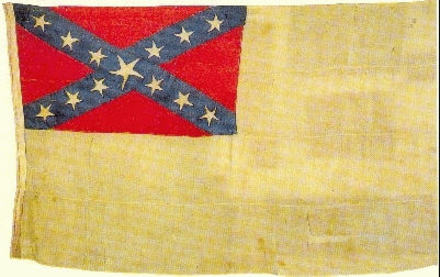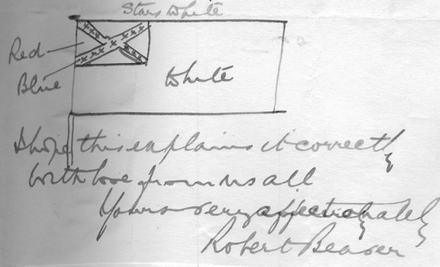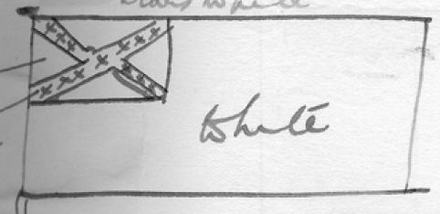


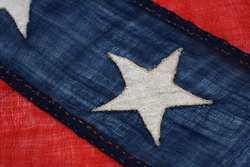




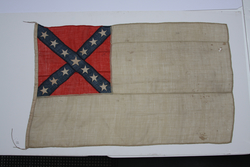


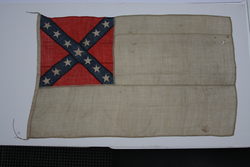
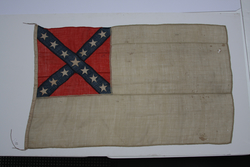

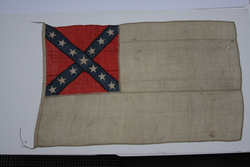
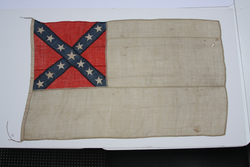



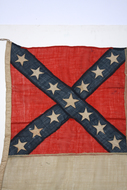
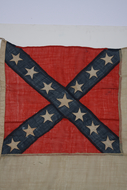

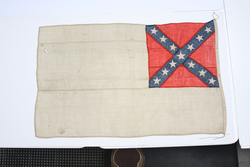
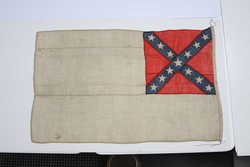
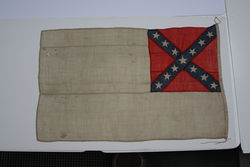
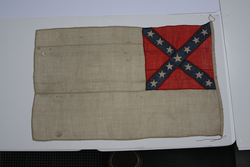
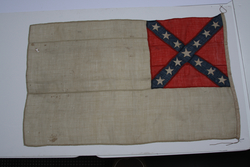
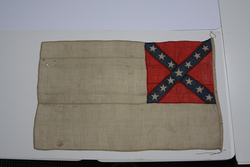

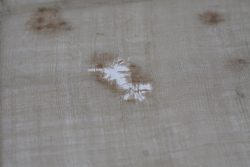

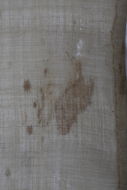


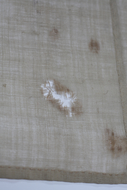
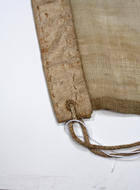

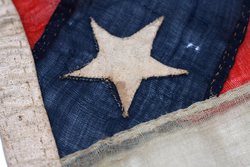


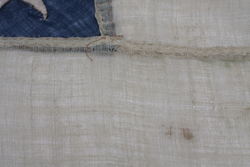
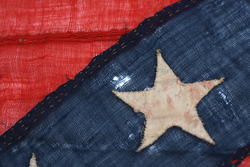
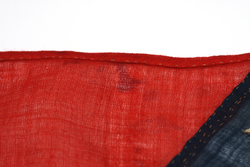
Second National Ensign of the CSS Alabama, 1864.
Sub-collection: Confederate FlagsSecond National Ensign of the CSS Alabama, June 1864.
This hand-sewn woolen, 40"x 65" flag is the second and final ensign from the CSS Alabama's last battle, hoisted after the spinnaker gaff on which she wore her ensign was shot away. This smaller ensign, likely the boat flag from the captain's gig, was eventually struck in a battle against the USS Kearsarge off the coast of France in June 1864.
The CSS Alabama was one of the most famous ships of the Confederate Navy. Perhaps second only to the battle between the USS Monitor and the CSS Virginia, the epic 19 June 1864 battle fought between the USS Kearsarge and the CSS Alabama off of Cherbourg, France is certainly the most romanticized.
The CSS Alabama was a commerce raider and the most successful of the ships of this ilk sent to sea by the self-styled Confederate States of America. Captained by Raphael Semmes, she secretly left the United Kingdom in July 1862 and was commissioned into the Navy to begin a global 22-month career, during which she would board 447 vessels of various nations, burn 55 and release 10 U.S. ships, and take and parole over 2,000 prisoners without losing any crew members or captives.
During this entire time, the CSS Alabama never entered a Confederate port, so she was entirely dependent on her own devices and an occasional foreign chandler for all of her flags and signals. When she was commissioned she broke out a Confederate first national ensign at her spinnaker gaff, and would display other ensigns and boat flags of this type until the design was changed by the Confederate Congress in 1863.
When the new flag was introduced, the CSS Alabama was cruising in the South Atlantic preparatory to entering the Indian Ocean and as such, it is highly unlikely that a copy of the Confederate Navy's 1863 Table of Allowances for Ensigns was ever delivered to the Alabama. Instead she relied on her prizes and occasional ports-of-call for her news. Exactly how or when she learned of the adoption of the second national flag is unknown but we do know that it was sometime late in 1863. We know this for in his memoir "Two Years on the Alabama", Lieutenant Arthur Sinclair wrote on page 210: "We show our bright white flag with the cross and stars, - strange flag to these skippers, as well as to the rest of our recent visitors; for we had only made and bent it since reaching the East and learning of the change".
It is probable that the CSS Alabama only learned of the new flag after reaching the British Straits settlements Crown Colony of Singapore, where Captain Semmes and his officers were feted for three days by the British merchant High Rowland Beaver. Beaver was the proprietor of Cumming, Beaver and Co., who later revictualed the Alabama from his own pocket.
What is clear that the CSS Alabama made her own ensigns and boat flags, and most likely this was done from an incomplete description or drawing. We know this as this flag does not bear the white fimbriation separating the blue arms of the St. Andrew's cross from the red background that is generally seen in the cantons of second national flags. Thanks to the absence of the white fimbriation, we can better understand this Alabama ensign.
Flags attributed to the CSS Alabama are not uncommon. There are nine flags attributed to the ship in museums or private collections. Two are first national pattern flags and one is a masthead pennant. Of the remaining six, one is a 108" x 186" silk presentation flag that was gifted to Captain Semmes and another is a 105" x 210" second national flag attributed to the CSS Alabama and later gifted to the Tennessee State Museum without provenance in 1977.
The remaining flags are all thought to be second national boat flags however, one of these is quite small 24" x 36" and therefore unlikely to be to be an actual boat flag. Interestingly, it also has the white fimbriation that the other Alabama boat flags lack. Furthermore, it was sold at auction with only an oral provenance making the Alabama attribution suspicious.
The remaining three Alabama flags are all similar in that they omit the white fimbriation in the canton. A 66" x 115", wool boat flag is in a collection in the Iziko Museum in Cape Town South Africa. Another wool boat flag, estimated to be about 38" X 56", is in the possession of the descendants of the Alabama's First Assistant Engineer William P Brooks, who according to the family took it before it sank.
The third flag is ZFC2590, which was acquired directly from the descendants of Hugh Rowland Beaver to whom it was presented to by officers from the CSS Alabama who were known to have visited him in his English home during the summer of 1864. Thus it seems from the surviving flags that the boat flags of the CSS Alabama were all shipboard made, all roughly the same size and fabric and all omitted the white fimbriation in the canton.
According to Captain Semmes' report of the battle, "…our spanker-gaff was shot away, and our ensign came down by the run. This was immediately replaced by another at the mizzen-masthead". (Semmes, Memoirs of Service Afloat p. 757)
According to Lt. I.S. Bulloch, the Alabama's navigator, who was quoted in the 8 May 1880 edition of the Chicago Daily Inter-Ocean, this flag was made shipboard by the sailing quartermaster and was used on the captains gig whenever it carried Capt. Semmes.
The Beaver-Leach family has always insisted that this is that very ensign and that it was later presented to the family by Captain Semmes in gratitude for Hugh Rowland Beaver's generous hospitality both in Singapore during the cruise and later at his estate in the United Kingdom.
The flag is wool and "roughly" made, typical of the type of flag one would expect from a ship-board fabricated flag. It is in good condition showing that it has endured only slight usage. The flag's condition not surprising as Alabama didn't take any prizes after spring 1864, as it was in transit to Europe for much-needed repairs and her small boats were stowed until the battle on 19 June 1864.
Exhibition History:
Private Exhibition
Washington Flag Congress, 2011
24th International Congress of Vexillology and
45th annual meeting of the North American Vexillological Association.
Washington, DC & Alexandria, VA
July 31-August 6, 2011
Private Presentation for Alabama Congressman Spencer Bachus (R)
Rayburn House Office Building
Washington, DC
1 August 2012
(See ZFC3716 - Congressman Bachus' gift of appreciation)
Publication History:
Dana, Charles, ed."The Flag of the Alabama" The Chicago Inter-Ocean, 8 May 1880.
Beaver, Hugh, "An Anglesey Sea Captain", Anglesey Antiquarian Society Transactions, 1928, p.59.
Leach, J.H., Mrs. "Letter of the great-great niece of Hugh Beaver", Mariner's Mirror, Vol. 59, No.3, August, 1973, p. 351.
Tucker, Neely, "Planting the flag with a collector's passion", The Washington Post, 4 August 2011, p. C1.
Provenance:
• CSS Alabama 1863 to 1864.
• Gifted as a token of esteem & gratitude to Hugh Rowland Beaver via the officers of the CSS Alabama, summer 1864.
• Thence by direct descent in the Beaver-Leach families to Robin Leach until 2012.
• Sold via auction at Sotheby's, New York, NY to the Zaricor Flag Collection, 2012.
Sources:
Sinclair, Arthur, Lieutenant, C.S.N., Two Years on the Alabama, Lee and Shepard Publishers, Boston,1895.
Semmes, Raphael, Admiral, C.S.N., Memoirs of Service Afloat, Kelly, Piet & Company, Baltimore, 1869.
Beaver, Hugh, "An Anglesey Sea Captain", Anglesey Antiquarian Society Transactions, 1928, p.59.
Dana, Charles, ed."The Flag of the Alabama" The Chicago Inter-Ocean, 8 May 1880, page 13.
Leach, J.H., Mrs. "Letter of the great-great niece of H ugh Beaver", Mariner's Mirror, Voil. 59, No.3, August, 1973, p. 351.
CSS Alabama, WIKIPEDIA, 89 July 2102, from:
http://en.wikipedia.org/wiki/CSS_Alabama
CSS Alabama Flag, Alabama Crew, 9 July 2012, from:
http://www.richard.thepaynes.btinternet.co.uk/alabamacrew/flag.htm
The Battle between CSS Alabama and USS Kearsarge, CSS Alabama Association, 9 July 2012, from:
http://www.css-alabama.com/engagement.html
CSS Alabama, A virtual Exhibit, 9 July 2012, from:
http://www.marshall.edu/library/speccoll/virtual_museum/css_alabama/default.asp
Image Credits:
Zaricor Flag Collection
Hoist & Fly | |
|---|---|
| Width of Hoist | 42 |
| Length of Fly | 65 |
Union/Canton | |
|---|---|
| Width of Union/Canton | 26.25 |
| Length of Union/Canton | 24.5 |
Stars | |
|---|---|
| Size of Stars | 3 |
Stripes | |
|---|---|
| Size of Hoist | 1.25 |
Frame | |
|---|---|
| Is it framed? | no |
Stars | |
|---|---|
| Number of Stars | 13 |
| How are the stars embeded? | Sewn |
| Are there stars on obverse? | yes |
| Are there stars on reverse? | yes |
| Comments on Stars | Double Applique |
| Star Pattern | St. Andrew's Cross |
Stripes | |
|---|---|
| Number of Stripes | 0 |
Crest/Emblem | |
|---|---|
| Description of Crest/Emblem | Variant of the Confederate Battle Flag in Canton. There is no fimbriation on the St. Andrew's Cross. |
Nationality | |
|---|---|
| Nation Represented | Confederate States |
Fabric | |
|---|---|
| Fabric | Wool |
| Comments on Fabric | Flag is made from three colors of plain weave wool |
Stitching | |
|---|---|
| Stitching | Hand |
| Comments on Stitching | All stitching is by hand, and "rough" of the type expected to be seen on 19th century, sailor-made flags. The flag is simply constructed. |
Thread | |
|---|---|
| Type of Thread | Combination of Threads |
| Thread Material | Combination |
| Comments on Thread Material | Threads are: Blue seams = Cotton 3-Ply, S twist Lower White Seam = Cotton 3-Ply, S twist Top white seam = Linen 3-Ply S Twist |
Weave | |
|---|---|
| Type of Weave | Plain |
Attachment | |
|---|---|
| Comments on Method of Attachmen | Whip-stitched eyelets with small cotton cords top and bottom |
| Method of Attachment | Whip-stitched |
Applica | |
|---|---|
| Applique Sides | Single Faced = Mirror Image Reverse |
Documentation | |
|---|---|
| Documents | |
| Drawings | |
| Research Documents | |
Condition | |
|---|---|
| Condition | Good |
| Damage | used, worn, mothed, stained. |
| Displayable | yes |
Date | |
|---|---|
| Date | 1863-1864 |
Exhibits | |
|---|---|
| Exhibition Copy | Exhibition History: Private Exhibition Luncheon Presentation 4 August 2011 Washington Flag Congress, 2011 24th International Congress of Vexillology and 45th annual meeting of the North American Vexillological Association. Washington, DC & Alexandria, VA (There was no gallery copy prepared for this exhibition.) The hand-out distributed to promote the Luncheon Presentation CSS Alabama, the second ensign from the final battle, hoisted after the spinnaker gaff with the ensign was shot away. This smaller ensign, likely a boat flag was eventually struck in battle against the USS Kearsarge off the coast of France in June 1864. (ZFC2590 = 39" X 64") |
Publications | |
|---|---|
| Publication Copy | Beaver, Hugh, "An Anglesey Sea Captain", Anglesey Antiquarian Society Transactions, 1928, p.59. Leach, J.H., Mrs. "Letter of the great-great niece of Hugh Beaver", Mariner's Mirror, Vol. 59, No.3, August, 1973, p. 351. Semmes, Raphael, Admiral, C.S.N., Memoirs of Service Afloat, Kelly, Piet & Company, Baltimore, 1869. P.757. "SIR:-I have the honor to inform you, that, in accordance with my intention as previously announced to you, I steamed out of the harbor of Cherbourg between nine and ten o'clock on the morning of the 19th of June, for the purpose of engaging the enemy's steamer Kearsarge, which had been lying off, and on the port, for several days previously. After clearing the harbor, we descried the enemy, with his head off shore, at the distance of about seven miles. We were three quarters of an hour in coming up with him. I had previously pivotted my guns to starboard, and made all preparations for engaging the enemy on that side. When within about a mile and a quarter of the enemy, he suddenly wheeled, and, bringing his head in shore, presented his starboard battery to me. By this time, we were distant about one mile from each other, when I opened on him with solid shot, to which he replied in a few minutes, and the action became active on both sides. The enemy now pressed his ship under a full head of steam, and to prevent our passing each other too speedily, and to keep our respective broadsides bearing, it became necessary to fight in a circle; the two ships steaming around a common centre, and preserving a distance from each other of from three quarters to half a mile. When we got within good shell range, we opened upon him with shell. Some ten or fifteen minutes after the commencement of the action, our spanker-gaff was shot away, and our ensign came down by the run. This was immediately replaced by another at the mizzen-masthead. The firing now became very hot, and the enemy's shot, and shell soon began to tell upon our hull, knocking down, killing, and disabling a number of men, at the same time, in different parts of the ship. Perceiving that our shell, though apparently exploding against the enemy's sides, were doing him but little damage, I returned to solid-shot firing, and from this time onward alternated with shot, and shell. After the lapse of about one hour and ten minutes, our ship was ascertained to be in a sinking condition, the enemy's shell having exploded in our side, and between decks, opening large apertures through which the water rushed with great rapidity. For some few minutes I had hopes of being able to reach the French coast, for which purpose I gave the ship all steam, and set such of the fore-and-aft sails as were available. The ship filled so rapidly, however, that before we had made much progress, the fires were extinguished in the furnaces, and we were evidently on the point of sinking. I now hauled down my colors, to prevent the further destruction of life, and dispatched a boat to inform the enemy of our condition. Although we were now but 400 yards from each other, the enemy fired upon me five times after my colors had been struck. It is charitable to suppose that a ship of war of a Christian [Pg 758] nation could not have done this, intentionally. We now directed all our exertions toward saving the wounded, and such of the boys of the ship as were unable to swim. These were dispatched in my quarter-boats, the only boats remaining to me; the waist-boats having been torn to pieces. Some twenty minutes after my furnace-fires had been extinguished, and when the ship was on the point of settling, every man, in obedience to a previous order which had been given the crew, jumped overboard, and endeavored to save himself. There was no appearance of any boat coming to me from the enemy, until after my ship went down. Fortunately, however, the steam-yacht Deerhound, owned by a gentleman of Lancashire, England-Mr. John Lancaster-who was himself on board, steamed up in the midst of my drowning men, and rescued a number of both officers and men from the water. I was fortunate enough myself thus to escape to the shelter of the neutral flag, together with about forty others, all told. About this time, the Kearsarge sent one, and then, tardily, another boat. Accompanying, you will find lists of the killed and wounded, and of those who were picked up by the Deerhound; the remainder, there is reason to hope, were picked up by the enemy, and by a couple of French pilot boats, which were also fortunately near the scene of action. At the end of the engagement, it was discovered by those of our officers who went alongside of the enemy's ship, with the wounded, that her mid-ship section, on both sides, was thoroughly iron-coated; this having been done with chains, constructed for the purpose, placed perpendicularly, from the rail to the water's edge, the whole covered over by a thin outer planking, which gave no indication of the armor beneath. This planking had been ripped off, in every direction, by our shot and shell, the chain broken, and indented in many places, and forced partly into the ship's side. She was effectually guarded, however, in this section, from penetration. The enemy was much damaged, in other parts, but to what extent it is now impossible to say. It is believed he is badly crippled. My officers and men behaved steadily and gallantly, and though they have lost their ship, they have not lost honor. Where all behaved so well, it would be invidious to particularize, but I cannot deny myself the pleasure of saying that Mr. Kell, my first lieutenant, deserves great credit for the fine condition in which the ship went into action, with regard to her battery, magazine and shell-rooms, and that he rendered me great assistance, by his coolness, and judgment, as the fight proceeded. The enemy was heavier than myself, both in ship, battery, and crew; but I did not know until the action was over, that she was also iron-clad. Our total loss in killed and wounded, is 30, to wit: 9 killed, and 21 wounded." Sinclair, Arthur, Lieutenant, C.S.N., Two Years on the Alabama, Lee and Shepard Publishers, Boston,1895. P.210 2IO TWO YEARS ON THE ALABAMA "…scenes as at Singamore [sic] are re-enacted - on a very small scale, but with the same hearty English warmth. Remain- ing long enough to land our prisoners, and give the colony time to inspect our ship, we bid adieu to both ; and with hearty exchanges of " Merry Christmas " and " Happy New Year," steam away, leaving them to the joys of the season, a boon beyond our reach. We pass our day, each rather gloomily wrapped in his own thoughts. What a Christmas to our beloved land - this day of peace and good-will among men ! We had opportunity to replenish our supply of fruit and vegetables, but no run on shore, excepting the boat's crew ; hence have no pleasant recollections of the little colony. We pass a number of foreign sails during the day, and at eight bells (supper-hour) give the only public reminder of the day by " splicing the main-brace ; " and though all hands have had a heavy pull at the Chinese ardent the past few days, still a " tot " of pure " Jamaica " may come in play> as "the hair of the dog is good for the bite." We are moving along under steam ; and just after din- ner make from the mast-head, dead ahead, two ships at anchor in the strait, waiting a fair wind. They have all the appearance of Americans in their spars ; though we have no opportunity of judging from the cut of their sails, they being clewed up and furled. But Evans pronounces them the right sort to our wishes. A short steam, and we are alongside of them. We show our bright white flag with the cross and stars, - a strange flag to these skippers, as well as to the rest of our recent visitors ; for we had only made and bent it since reaching the East and learn- ing of the change. There is no occasion for subterfuges ; so we are answered at once by the stars and stripes from both of them. On boarding, they proved to be the Sonora, of Newburyport, and the Highlander, of Boston, bound in ballast from Singapore to Akyab, where they…" |
| Publication Images | |

